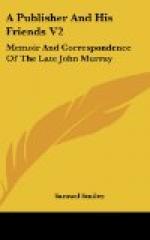In compliance with the suggestions of the publisher, Byron altered and improved the stanzas relating to Elgin and Wellington. With respect to the religious, or anti-religious sentiments, Byron wrote to Murray: “As for the ‘orthodox,’ let us hope they will buy on purpose to abuse—you will forgive the one if they will do the other.” Yet he did alter Stanza VIII, and inserted what Moore calls a “magnificent stanza” in place of one that was churlish and sneering, and in all respects very much inferior.
Byron then proceeded to another point. “Tell me fairly, did you show the MS. to some of your corps?” “I will have no traps for applause,” he wrote to Mr. Murray, at the same time forbidding him to show the manuscript of “Childe Harold” to his Aristarchus, Mr. Gifford, though he had no objection to letting it be seen by any one else. But it was too late. Mr. Gifford had already seen the manuscript, and pronounced a favourable opinion as to its great poetic merits. Byron was not satisfied with this assurance, and seemed, in his next letter, to be very angry. He could not bear to have it thought that he was endeavouring to ensure a favourable review of his work in the Quarterly. To Mr. Dallas he wrote (September 23, 1811):
“I will be angry with Murray. It was a book-selling, back-shop, Paternoster Row, paltry proceeding; and if the experiment had turned out as it deserved, I would have raised all Fleet Street, and borrowed the giant’s staff from St. Dunstan’s Church, to immolate the betrayer of trust. I have written to him as he was never written to before by an author, I’ll be sworn; and I hope you will amplify my wrath, till it has an effect upon him.”
Byron at first objected to allow the new poem to be published with his name, thinking that this would bring down upon him the enmity of his critics in the North, as well as the venom of the southern scribblers, whom he had enraged by his Satire. At last, on Mr. Murray’s strong representation, he consented to allow his name to be published on the title-page as the author. Even to the last, however, his doubts were great as to the probable success of the poem; and he more than once talked of suppressing it.
In October 1811 Lord Byron wrote from Newstead Abbey to his friend Mr. Hodgson: [Footnote: The Rev. Francis Hodgson was then residing at Cambridge as Fellow and Tutor of King’s College. He formed an intimate friendship with Byron, who communicated with him freely as to his poetical as well as his religious difficulties. Hodgson afterwards became Provost of Eton.]
“‘Childe Harold’s Pilgrimage’ must wait till Murray’s is finished. He is making a tour in Middlesex, and is to return soon, when high matter may be expected. He wants to have it in quarto, which is a cursed unsaleable size; but it is pestilent long, and one must obey one’s publisher.”
The whole of the sheets were printed off in the following month of January; and the work was published on March 1, 1812. Of the first edition only 500 copies, demy quarto, were printed.




